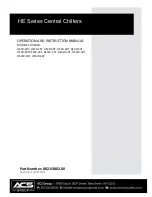
8
IOM 1206-1
Installation and Application Information
13
Perform a preliminary leak check before insulating the
piping and filling the system.
14
Piping insulation should include a vapor barrier to
prevent condensation and possible damage to the
building structure.
Water Connections
Bring water piping to the evaporator through the side between
the vertical supports. Provide taps for the connection of
pressure gauges and thermometers in the inlet and outlet lines.
Check the inlet and outlet labels on the unit against the
certified drawings supplied on the job and be sure the water
piping is hooked up correctly. Contact the Daikin Applied
sales office if any discrepancies exist.
System Water Volume Considerations
All chilled water systems need adequate time to recognize a
load change, respond to that load change and stabilize, without
undesirable short cycling of the compressors or loss of control.
In air conditioning systems, the potential for short cycling
usually exists when the building load falls below the minimum
chiller plant capacity or on close-coupled systems with very
small water volumes. Some of the things the designer should
consider when looking at water volume are the minimum
cooling load, the minimum chiller plant capacity during the
low load period and the desired cycle time for the
compressors. Assuming that there are no sudden load changes
and that the chiller plant has reasonable turndown, a rule of
thumb of "gallons of water volume equal to two to three times
the chilled water gpm flow rate" is often used. A storage tank
may have to be added to the system.
BAS should enable chiller only when there is a cooling
demand.
Evaporator Freeze Protection
Evaporator freeze-up can be a concern in the application of air-
cooled water chillers. To protect against freeze-up, insulation
and electric heaters are furnished with the unit; models 030
through 070 have an external plate heater and thermostat. They
protect the evaporator down to -20° F (-29° C) ambient air
temperature. Although the evaporator is equipped with freeze
protection, it does not protect water piping external to the unit
or the evaporator itself if there is a power failure or heater
cable burnout, or if the chiller is unable to control the chilled
water pumps. Use one of the following recommendations for
additional protection:
1
If the unit will not be operated during the winter, drain
evaporator and chilled water piping and flush with
glycol.
2
Add a glycol solution to the chilled water system to
provide freeze protection. Freeze point should be
approximately ten degrees (F) below minimum design
ambient temperature.
3
The addition of thermostatically controlled heat and
insulation to exposed piping.
The evaporator heater cable is factory wired to the 115 volt
circuit in the control box. This power should be supplied from
a separate source, but it can be supplied from the control
circuit. Operation of the heaters is automatic through the
ambient sensing thermostat that energizes the evaporator
heaters for protection against freeze-up. Unless the evaporator
is drained in the winter or contains an adequate concentration
of anti-freeze, the disconnect switch to the evaporator heater
must not be open.
Chilled Water Pump
It is important that the chilled water pumps be wired to, and
controlled by, the chiller's microprocessor. When equipped
with optional dual pump output, the chiller controller has the
capability to selectively send the signal to a pump relay (by
others) to start pump A or B or automatically alternate pump
selection and also has standby operation capability. The
controller will energize the pump whenever at least one circuit
on the chiller is enabled to run, whether there is a call for
cooling or not. This helps ensure proper unit start-up sequence.
The pump will also be turned on when the water temperature
reaches 1°F below the Freeze Setpoint to help prevent
evaporator freeze-up. Connection points are shown in the Field
Wiring Diagram on
page 20
.
Failure to allow pump control by the chiller may cause the
following problems:
1
If any device other than the chiller attempts to start the
chiller without first starting the pump, the chiller will
lock out on the No Flow alarm and require manual reset.
2
If the chiller evaporator water temperature drops below
the “Freeze setpoint” the chiller will attempt to start the
water pumps to avoid evaporator freeze. If the chiller
does not have the ability to start the pumps, the chiller
will alarm due to lack of water flow.
3
If the chiller does not have the ability to control the
pumps and the water system is not to be drained in
temperatures below freezing, the chiller may be subject
to catastrophic evaporator failure due to freezing. The
freeze rating of the evaporator is based on the immersion
heater and pump operation. The immersion heater itself
may not be able to properly protect the evaporator from
freezing without circulation of water.
CAUTION
Adding glycol or draining the system is the recommended method of
freeze protection. If the chiller does not have the ability to control the
pumps and the water system is not drained in temperatures below
freezing, catastrophic evaporator failure may occur.









































